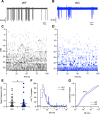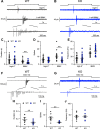A Role for STOML3 in Olfactory Sensory Transduction
- PMID: 33637538
- PMCID: PMC7986538
- DOI: 10.1523/ENEURO.0565-20.2021
A Role for STOML3 in Olfactory Sensory Transduction
Abstract
Stomatin-like protein-3 (STOML3) is an integral membrane protein expressed in the cilia of olfactory sensory neurons (OSNs), but its functional role in this cell type has never been addressed. STOML3 is also expressed in dorsal root ganglia neurons, where it has been shown to be required for normal touch sensation. Here, we extended previous results indicating that STOML3 is mainly expressed in the knob and proximal cilia of OSNs. We additionally showed that mice lacking STOML3 have a morphologically normal olfactory epithelium. Because of its presence in the cilia, together with known olfactory transduction components, we hypothesized that STOML3 could be involved in modulating odorant responses in OSNs. To investigate the functional role of STOML3, we performed loose patch recordings from wild-type (WT) and Stoml3 knock-out (KO) OSNs. We found that spontaneous mean firing activity was lower with additional shift in interspike intervals (ISIs) distributions in Stoml3 KOs compared with WT neurons. Moreover, the firing activity in response to stimuli was reduced both in spike number and duration in neurons lacking STOML3 compared with WT neurons. Control experiments suggested that the primary deficit in neurons lacking STOML3 was at the level of transduction and not at the level of action potential generation. We conclude that STOML3 has a physiological role in olfaction, being required for normal sensory encoding by OSNs.
Keywords: ion channel; olfactory; transduction.
Copyright © 2021 Agostinelli et al.
Figures





Similar articles
-
Expression pattern of Stomatin-domain proteins in the peripheral olfactory system.Sci Rep. 2022 Jul 6;12(1):11447. doi: 10.1038/s41598-022-15572-1. Sci Rep. 2022. PMID: 35794236 Free PMC article.
-
The Ca2+-activated Cl- channel TMEM16B regulates action potential firing and axonal targeting in olfactory sensory neurons.J Gen Physiol. 2016 Oct;148(4):293-311. doi: 10.1085/jgp.201611622. Epub 2016 Sep 12. J Gen Physiol. 2016. PMID: 27619419 Free PMC article.
-
Regulation of ASIC channels by a stomatin/STOML3 complex located in a mobile vesicle pool in sensory neurons.Open Biol. 2012 Jun;2(6):120096. doi: 10.1098/rsob.120096. Open Biol. 2012. PMID: 22773952 Free PMC article.
-
Maturation of the Olfactory Sensory Neuron and Its Cilia.Chem Senses. 2020 Dec 5;45(9):805-822. doi: 10.1093/chemse/bjaa070. Chem Senses. 2020. PMID: 33075817 Free PMC article. Review.
-
Anoctamin 2/TMEM16B: a calcium-activated chloride channel in olfactory transduction.Exp Physiol. 2012 Feb;97(2):193-9. doi: 10.1113/expphysiol.2011.058230. Epub 2011 Sep 2. Exp Physiol. 2012. PMID: 21890523 Review.
Cited by
-
Technique of flat-mount immunostaining for mapping the olfactory epithelium and counting the olfactory sensory neurons.PLoS One. 2023 Jan 17;18(1):e0280497. doi: 10.1371/journal.pone.0280497. eCollection 2023. PLoS One. 2023. PMID: 36649285 Free PMC article.
-
Expression pattern of Stomatin-domain proteins in the peripheral olfactory system.Sci Rep. 2022 Jul 6;12(1):11447. doi: 10.1038/s41598-022-15572-1. Sci Rep. 2022. PMID: 35794236 Free PMC article.
-
A Conserved Role for Stomatin Domain Genes in Olfactory Behavior.eNeuro. 2023 Mar 22;10(3):ENEURO.0457-22.2023. doi: 10.1523/ENEURO.0457-22.2023. Print 2023 Mar. eNeuro. 2023. PMID: 36858824 Free PMC article.
-
Shedding light on human olfaction: Electrophysiological recordings from sensory neurons in acute slices of olfactory epithelium.iScience. 2023 Jun 21;26(7):107186. doi: 10.1016/j.isci.2023.107186. eCollection 2023 Jul 21. iScience. 2023. PMID: 37456832 Free PMC article.
-
The Aquaporin-4 Expression and Localization in the Olfactory Epithelium Modulate the Odorant-Evoked Responses and Olfactory-Driven Behavior.Glia. 2025 Aug;73(8):1642-1659. doi: 10.1002/glia.70024. Epub 2025 Apr 18. Glia. 2025. PMID: 40251831 Free PMC article.
References
-
- Baumgart S, Jansen F, Bintig W, Kalbe B, Herrmann C, Klumpers F, Köster SD, Scholz P, Rasche S, Dooley R, Metzler-Nolte N, Spehr M, Hatt H, Neuhaus EM (2014) The scaffold protein MUPP1 regulates odorant-mediated signaling in olfactory sensory neurons. J Cell Sci 127:2518–2527. 10.1242/jcs.144220 - DOI - PubMed
Publication types
MeSH terms
Substances
LinkOut - more resources
Full Text Sources
Other Literature Sources
Molecular Biology Databases
Research Materials
